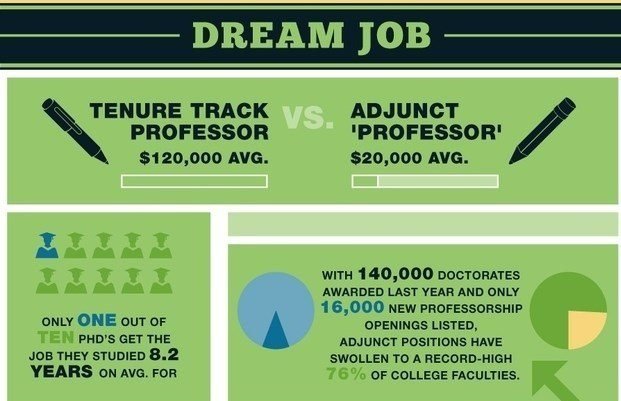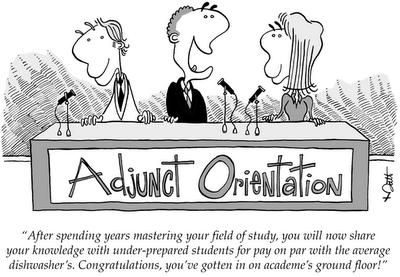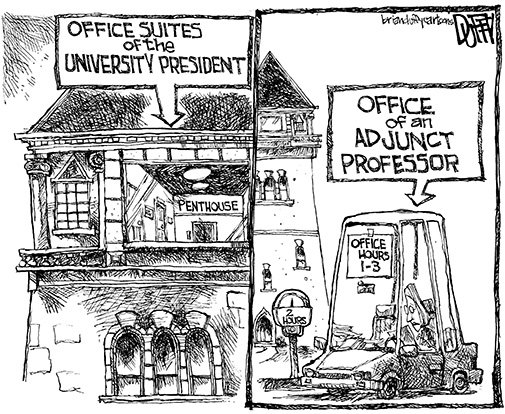For Higher Education to Survive, Adjuncting Needs to Die

It started as a way to give retired professors something to do. The professor would be offered one class, maybe two, but not be hired back full time (as that would interfere with pensions), but hold onto the joy of educating students, working with young people, and passing on knowledge. At the end, they would be given an honorarium, for their work and trouble, not so much that it would trouble retirement benefits, and they could continue doing so until they died. In the 1960s, these professors, or adjuncts, would comprise 25% of the workforce. Today, they comprise more than half.
An Adjunct Instructor/Professor will make on average $25,000 a year, compared to full-time faculty that average $55,300 for the year, with a slightly higher course-load, tenured job security, full benefits, and medical coverage. Adjuncts rarely receive such benefits, and in fact were harmed by the Affordable Care Act, or rather, harmed by colleges and universities that cut pay, and class load to prevent adjuncts from receiving federally mandated offers of employer-based health coverage. Instead, adjuncts are often instructed to attend meetings where they will be given guidance on how to apply for Medicaid and Temporary Assistance for Needy Families (TANF), more commonly known as “food stamps” (though in the US traditional paper stamps have been espoused for EBT methods). Be reminded that in order to become an adjunct professor, colleges require at minimum a master’s degree in the chosen field, an academic achievement that will often accrue over $60,000 in student loan debt, and not uncommonly in excess of $100,000.

Primarily, I believe, the reason for the abhorrent treatment of adjuncts could simply be applied to supply and demand. Considering the large output of graduates with master’s degrees, particularly in the humanities, for-profit colleges, community colleges, and four-year colleges and universities could be either more choosy in who they chose to hire, or, in the case of most US colleges, expand their programs by way of supplementing department needs with what could be best described as freelance academics.
What I believe is the reason for this expansion is this: adjuncts are rarely, if ever, asked to teach upper-division courses, often assigned to remedial, required, or general education courses assigned to college freshmen. With an incoming freshman class, attrition is at its highest, but they are a veritable cash cow of federal student aid in the form of loans, grants, and financed tuition payments. As full-time faculty are only required to teach so many introductory courses, adjuncts are brought on to pick up the slack either created by a lack of full-time faculty, or a glut of introductory sections added in the weeks before the start of a semester. It is not at all uncommon for an adjunct instructor to be held in limbo on whether or not they will be working until 72 hours before the start of the semester, sometimes learning of a course offer on the literal first day of class. This is only accomplished by assigned department mandated syllabi that can be taught by anyone with a reasonable understanding of the subject matter (hence only a bachelor’s degree being required at some online schools).
If the question is asked of why universities don’t simply hire more teachers to lessen course-loads, or give more than a cookie-cutter syllabus for an introductory course, the answer can be seen as a purely capitalist response. As an example, we will consider the cost/benefit of a freshman English class.
Let us suppose that a college charges its students $408 per credit hour (A typical rate for a community college). As Freshman English is a 3.0 hour course, the tuition cost rises to $1,224 to pay for the class, not including price of books. A filled class roster is 25 students to 1 instructor, bringing the initial tuition revenue to $30,600. A full-time professor making $55,000 must teach four total classes to maintain full-time status. Office hours, department meetings, and student advisement are considered to comprise 33% of a full-timer’s workload, but 25% by conservative estimates, making for an estimate of $41,250 paid for their time spent in a classroom and grading papers/assignments, and having office hours, bringing their pay per class to $10,312, plus additional costs for medical coverage, union protections, and retirement matching. An adjunct instructor is paid $3500 flat, on average, for the same academic labor, with no additional cost for medical coverage, retirement matching, or union protections, because those are not offered to part-time faculty. Returning the to $30,600 tuition revenue, subtracting pay for the instructor, the college can consider a profit of $20,288 with a full-time instructor, versus $27,100 with an adjunct. Now consider that the college will offer 95 sections to accommodate an incoming class of 2400 students. The potential profit changes from $1,927, 360 by hiring full timers to cover the course load, versus $2,574,000 by utilizing adjuncts. An additional $650,000 in profit for just one course, required and assigned to incoming freshmen who have to often take three to four other classes that are just as required.

The reliance on adjuncts results in justifications for administrative bloat, with new positions created on a yearly basis with six-figure salaries to further entrench the need for low-paid faculty to pay for skyrocketing administrative budgets that do little to reduce attrition or improve enrollment. With the aforementioned glut of graduates holding masters and other terminal degrees, especially in the humanities, adjunct work is often plentiful in the fall, and non-existent in the spring.
As adjuncts are primarily assigned courses that are required for freshmen, syllabi are often assigned as well, with textbooks already chosen, and assignments set in stone as department requirements. While this can be helpful for some incoming students who come from uniformly designed curriculums, others may see the work as “more of the same”. This argument is covered in Rebecca Cox’s study The College Fear Factor: How Students and Professors Misunderstand Each Other, where Cox reviews a 5 year embedded study at community colleges to determine the reason for increasing student attrition rates and lessening satisfaction both on the student and faculty levels in 2002. By reducing the allowance for creative approaches to pedagogy, or student input on course direction, it’s only the surprise that students adopting a “get it over with” or “Cs Get Degrees” mentality, or that assigning the same cookie-cutter syllabi for repeated semesters results in an uptick of plagiarism, is at all surprising to educators. By issuing course syllabi and schedules to incoming adjuncts to be followed verbatim with no deviation, the course material results in not only being non-engaging for students, but non-challenging for professors, causing a drop in satisfaction on both sides of the classroom.
The counterargument, understandably, would come from adjuncts themselves, as the work, no matter how underpaid or underserved, is often the only source of income that such academics believe is available to them, as education is deemed a necessary field by society, but a dead end as far as career choice is concerned. Despite stories of adjuncts living in their cars, working multiple jobs, or sometimes even entering the sex industry to afford increasing costs of living that don’t match stagnating adjunct wages, adjuncts return to colleges semester after semester looking for work, and shout in fruitless indignation when their tribulations go unnoticed, or more commonly, not cared about. That adjuncts are so willing to suffer disrespect, low pay, zero-to-little benefits, and scarce representation in the way of union action or political advocacy speaks not only to their devotion to their work, but also their crippling attitude regarding the worth of their profession, an attitude that is readily conditioned by college administrations.

It is not uncommon for new adjuncts to enter into the profession with the suggestion that work as an adjunct will provide the necessary classroom experience and time spent in academia to fulfill requirements to ascend to the first steps of the tenure track. This idea is readily fostered by departments and administrations to recruit students fresh from graduate school or secondary education to make the leap into the education arm of academia, though the vast majority of new or open tenure-track positions are filled by outside hires or “friends” of administrations and department heads. To make it through the first round of interviews for an open tenure-track position is considered a rarity among adjuncts, and some adjuncts leave adjunct experience off of their curriculum vitae for fear of being tossed aside. However, unless one is willing and able to look worldwide in their search for full-time positions, adjuncting at local colleges is often the only available avenue for education’s working poor, leaving advancement to more affluent and privileged (read: white middle class) educators.
Still, the promise of potential advancement is often enough for administrations and departments to keep unruly adjuncts in line. Like the elementary school threat of the “permanent record”, adjuncts work in fear and anxiety that any appearances of not being a
“team player” will permanently erase any chances to advancement to the tenure track, even though, in reality, such chances will never truly materialize. Administrations capitalize on these anxieties by lumping additional responsibilities onto adjuncts that they are neither trained, qualified, or paid for, such as student advocacy, recruitment, attrition prevention, counseling, and constant vigilance of any student that might pose a physical threat to themselves or others, all for a salary that pays, on average, less than a job at McDonald’s, a career that does not require even a high school diploma. To rebel, complain, or even publicly note that treatment is unfair is often only done anonymously to prevent any loss of class assignments, or classes being cancelled or given to more collaborative adjuncts.
It is because of this that it is not unheard of for adjuncts to be compared to the lower-half of an abusive relationship, as adjuncts live under administrations that dictate their schedules, pay, and health coverage, literally putting administrations in control of an adjunct’s physical, financial, and emotional well-being. This treatment, of course, is steered for the benefit of administration, with little to no concern given to those abused, and threatening the only aspect of the work that adjuncts enjoy: teaching students. Administrations often find their Quisling collaborators in department chairs, often hand-picked by administration for their pliability and loyalty, claiming a “students first” mission statement while underserving those students they claim to exalt with exhausted, overworked, underpaid contingent faculty.
Given that freshman attrition rates rise with lowered quality of teaching experience, it is simple for colleges to heap the blame upon their underpaid adjuncts who are largely responsible for shepherding new college students through the anxiety-inducing transition from high school to college. Also, students are limited in their perspective of seeing their educational experience largely from the classroom level, with their professors the only faces visible of the institution, with administrators only names on e-mail blasts or speakers at graduation despite their six-figure salaries, and the majority of students are only concerned, understandably, for their own well-being. While some students voice shock or appalment at learning the destitute circumstances of some of their instructors, that shock rarely even reaches tweet-worthy status. Since adjuncts are paid minimally, office hours are often the gap between offered classes, and can be difficult for students to reach for one-on-one interaction to explain issues with assignments and forge connections that can help retention. Full-time faculty is paid for office hours, and are required to offer them, but contingent/adjunct faculty is not, relegating office hours as unpaid volunteer time which administrations and departments will pressure adjuncts to give, but with no offers of pay. Considering the number of adjuncts who either work at multiple schools or have multiple jobs, even volunteered hours are a difficult ask. The students, and the adjuncts, suffer, but administrations will still collect their pay. If administrations suddenly found themselves without an adjunct population to exploit, real change would have to be affected.
This is a pipe dream, of course, as luring bloat-loaded administrations away from the for-profit models of defunct online universities is nigh-impossible without government intervention, and even in vaunted liberal bastions such as New York and California, tuition hikes have always been seen as the easy solution for closing state budget gaps, given the readily available access to federal student loans, grants, and aid to cover rising costs. Attrition and retention will always been an issue at all colleges and universities, but until the non-student-based causes for that attrition is examined and addressed with real change, education will continue to suffer while those in charge of it push academia from it’s knowledge and improvement based paradigm into a for-profit model only benefitting those at the top by continuing to exploit the adjunct population. So, in order for education to recover and survive, adjuncting as a practice needs to die.
Posted from my blog with SteemPress : https://vaughndemont.com/2018/12/03/for-higher-education-to-survive-adjuncting-needs-to-die/
Congratulations @vaughndemont! You have completed the following achievement on the Steem blockchain and have been rewarded with new badge(s) :
Click here to view your Board
If you no longer want to receive notifications, reply to this comment with the word
STOPCongratulations @vaughndemont! You received a personal award!
Click here to view your Board